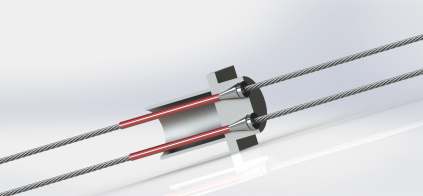POST TENSIONING
Properties
Post tensioning is a concrete reinforcement technique. Post tensioning tendons which provides pre-tensioning of steel ropes inside the plastic channels or couplers are placed in the forms before placing the
concrete. After the concrete is strengthened, the ropes are swiftlypulled or stretched before applying the service loads and leaned against the outer edges of the concrete.
The initial pressure simply means that the steel is stretched (pulled or stretched) before the concrete supports the service loads. Prestressed precast is actually pulled before the prestressed steel concrete is casted. Post-stressed concrete means that the concrete is casted and then stressed; however, it is still stretched before the loads are applied and stretching continues.
Stretching elements of stretching method consist of rope bundles with high breaking strength. With variations of number of ropes and if needed, variations of rope diameters and quality of the steel, it is possible to obtain a great diversity as rope units with breaking strength between 160 — 16.000 KN in standard units. Larger ropes can be manufactured for special applications.
After stretching, the cables are wedged in an anchor which allows the tensile force to be transferred to the structure. The basis of the post tension method is type anchors
Tensioning Anchors
Post Tension-type tensioning anchors help to anchor and stretch the ropes. These are designed according to the principle of anchoring each rope individually by means of compressors.

The prestressing force is transferred to concrete by a rigid anchor plate. The spirals surround too much concrete in the zone behind the anchor plate. The tensile forces in the anchor zone should be met with an additional soft reinforcement. The reinforcement is determined by considering the shape and dimensions of the anchor plate as well as the dimensions of the end region. Stretching anchors can also be used as
fixed anchors. In this case, the anchor head must remain stable during the tensioning process.
Post Tensioning On The Floor

Post-tensioning reinforced concrete floors have become an important factor for all types of commercial and residential projects, and floor systems. There are two popular methods in flooring systems. Unidirectional pavement slabs, bi-directional pavement slabs. It has been determined that it is economical in parking structure applications, apartment buildings, office buildings, hospitals, high or low office buildings and industrial buildings. With this technology, the problem of cracking which cannot be solved by traditional methods can be solved. Other factors contributing to the growth of post-tensioning construction work include:
- Simplified plain manufacturing methods have been developed for application.
- Test methods have been developed to understand the behavior of reinforced concrete and more economical and safe designs are made according to new criteria.



Post-tensioning systems are applied in bridge constructions, high-rise constructions, earth-rock anchors, parking constructions, underground constructions. Economic and safe solutions are reached in heavy loads and wide openings.
- One rope and all ropes should be simultaneously stretched, but each rope must be wedged into the anchor one by one.
- Convenience for various rope diameters and quality.
- Standardized rope units with tensile strength up to 16,000 KN.
- Large variety that can meet all requirements in the anchor system.
- Use of rational methods, suitable materials and simple tools.
- Possibility of stretching the rope at desired stage or step.
- Flawless injection possibility provided by the rope’s screw effect.
- In general, anchor is composed of a cylindrical anchor head with tapered holes, tighteners (wedges), anchor coupler, ropes and an anchor plate.
- All the ropes of a cable are stretched at the same time, but each rope is seated one by one with wedges into a tapered hole in the anchor head. Continuity of the wedging is ensured by continuous contact between the wedges and the ropes.




